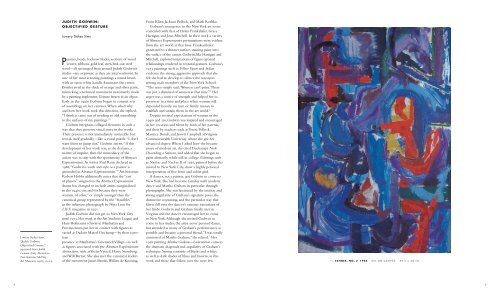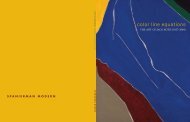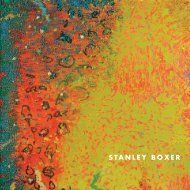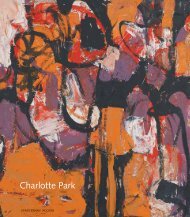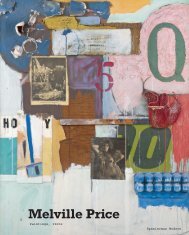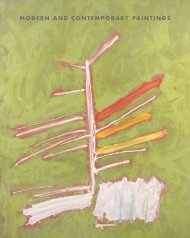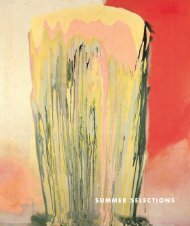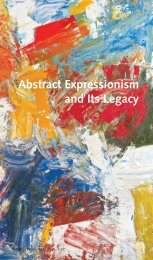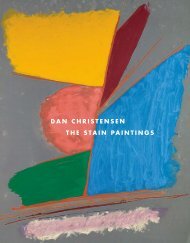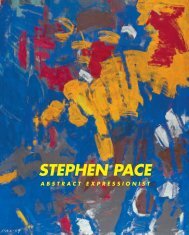View the catalogue as a PDF - Spanierman Modern
View the catalogue as a PDF - Spanierman Modern
View the catalogue as a PDF - Spanierman Modern
- No tags were found...
Create successful ePaper yourself
Turn your PDF publications into a flip-book with our unique Google optimized e-Paper software.
Lowery Stokes Sims,“Judith Godwin:Objectified Gesture,”reprinted from JudithGodwin: Early Abstractions(San Antonio: McNayArt Museum, 2008), 10–14.JUDITH GODWIN:OBJECTIFIED GESTURELowery Stokes SimsPennies, beads, hacksaw blades, sections of woodveneer, ribbons, gold leaf, stretched-out steelwool—all scrounged from around Judith Godwin’sstudio—are <strong>as</strong> prosaic <strong>as</strong> <strong>the</strong>y are interventionist. Inone of her most arresting paintings a round brushwith an open white handle dominates <strong>the</strong> center.Bristles swirl in <strong>the</strong> thick of orange and silver paint,mimicking a technical movement customarily madeby a painting implement. Gesture frozen in an object.Early in <strong>the</strong> 1990s Godwin began to commit actsof <strong>as</strong>semblage on her canv<strong>as</strong>es. When <strong>as</strong>ked whyand how her work took this direction, she replied,“I think it came out of needing to add somethingto <strong>the</strong> surfaces of my paintings.” 1Godwin integrates collaged elements in such away that <strong>the</strong>y preserve visual unity in <strong>the</strong> works.Their presence is not immediately noticeable butreveals itself gradually—like a visual puzzle. “I don’twant <strong>the</strong>m to jump out,” Godwin <strong>as</strong>serts. 2 If thisdevelopment of her work w<strong>as</strong>, <strong>as</strong> she declares, amatter of impulse, <strong>the</strong>n <strong>the</strong> immediacy of <strong>the</strong>action w<strong>as</strong> in step with <strong>the</strong> spontaneity of AbstractExpressionism. As writer Paul Ryan declared in1988, “Godwin’s work and style <strong>as</strong> a painter isgrounded in Abstract Expressionism.” 3 Art historianRobert Hobbs additionally notes that <strong>the</strong> “c<strong>as</strong>tof players” <strong>as</strong>signed to <strong>the</strong> Abstract Expressionistdrama h<strong>as</strong> changed to include artists marginalizedin <strong>the</strong> 1940s, 50s, and 60s because <strong>the</strong>y werewomen, of color, 4 or simply younger than <strong>the</strong>canonical group represented by <strong>the</strong> “Ir<strong>as</strong>cibles”in <strong>the</strong> infamous photograph by Nina Leen forLIFE magazine in 1951.Judith Godwin did not get to New York Cityuntil 1953. Her work at <strong>the</strong> Art Students League andHans Hofmann’s schools in Manhattan andProvince town put her in contact with figures <strong>as</strong>varied <strong>as</strong> Dadaist Marcel Duchamp—by <strong>the</strong>n a proteanpresence in Manhattan’s Greenwich Village—<strong>as</strong> well<strong>as</strong> figures <strong>as</strong>sociated with pre-Abstract Expressionistabstraction, such <strong>as</strong> Vaclav Vytacil, Harry Sternberg,and Will Barnet. She also met <strong>the</strong> canonical leadersof <strong>the</strong> movement: James Brooks, Willem de Kooning,Franz Kline, Jackson Pollock, and Mark Rothko.Godwin’s emergence in <strong>the</strong> New York art scenecoincided with that of Helen Frankthaler, GraceHartigan, and Joan Mitchell. In <strong>the</strong>ir work a varietyof Abstract Expressionist permutations were evidentfrom <strong>the</strong> art world at that time. Frankenthalergravitated to a thinner surface, staining paint into<strong>the</strong> surface of <strong>the</strong> canv<strong>as</strong>. Godwin, like Hartigan andMitchell, explored intimations of figure/groundrelationships rendered in textural gestures. Godwin’s1953 paintings such <strong>as</strong> Yellow Figure and Indianevidence <strong>the</strong> strong, aggressive approach that shefelt she had to develop to silence <strong>the</strong> naysayersamong male members of <strong>the</strong> New York School.“The men simply said, ‘Women can’t paint.’ Therew<strong>as</strong> just a dismissal of women at that time.” 5 Heranger w<strong>as</strong> a source of strength and helped her topersevere in a time and place when women stilldepended heavily on men or family money toestablish and sustain <strong>the</strong>m in <strong>the</strong> art world. 6Despite societal expectations of women in <strong>the</strong>1940s and 50s, Godwin w<strong>as</strong> inspired and encouragedin her vocation and talent by both of her parents,and <strong>the</strong>n by teachers such <strong>as</strong> Teresa Pollock,Maurice Bonds, and Jewett Campbell at VirginiaCommonwealth University where she got heradvanced degree. When I <strong>as</strong>ked how she becameaware of modern art, she cited Duchamp’s NudeDescending a Stairc<strong>as</strong>e, and added that she began topaint abstractly while still in college. Paintings such<strong>as</strong> Nucleus and Nucleus II of 1950, painted before shemoved to New York City, show a highly personalinterpretation of free form and cubist gird.A dancer, not a painter, got Godwin to come toNew York. She had become familiar with moderndance and Martha Graham in particular throughphotographs. She w<strong>as</strong> f<strong>as</strong>cinated by <strong>the</strong> motion andstrong angularity of Graham’s signature poses, <strong>the</strong>distinctive costuming, and <strong>the</strong> particular way thatfabric fell over <strong>the</strong> dancer’s extreme extensions ofher limbs. Godwin and Graham finally met inVirginia and <strong>the</strong> dancer encouraged her to cometo New York. Although she invited Godwin tocome to her studio, <strong>the</strong> artist never pursued dance,but attended <strong>as</strong> many of Graham’s performances <strong>as</strong>possible and became a personal friend. “I w<strong>as</strong> totallyenamored of Martha Graham,” she related. 7 Her1956 painting Martha Graham—Lamentation conveys<strong>the</strong> dramatic diagonals and angularity of Graham’stechnique. Strong contr<strong>as</strong>ts of blacks and whites,<strong>as</strong> well <strong>as</strong> dark shades of blues and browns, in thiswork and those that follow over <strong>the</strong> next few1. ECHOES, NO. 2 1954 OIL ON CANVAS 40 3 ⁄4 x 30 IN.45


